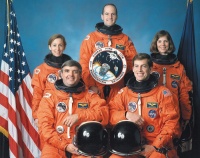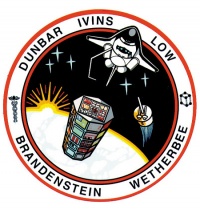STS-32
From The Space Library
 | |
| Organization | NASA-Office of Space Flight (United States) |
|---|---|
| Mission type | Human Crew |
| Launch date | January 9, 1990 |
| Launch vehicle | Space Shuttle |
| Launch site | Cape Canaveral, United States |
| COSPAR ID | 1990-002A |
| Inclination | 28.5 degrees |
| Experiments | Here |
| Alternate Names | 20409 |
| Additional Information | Here |
| Data Collection | Here |
| Payload Mass Up | 12014 kg |
| Payload Mass Down | 9724.09 kg |
| Orbiter | Columbia |
| Lift Off Mass | 2,054,312.27 kg |
| Orbiter Weight at Liftoff | 116,360.91 kg |
| Orbiter Weight at Landing | 103,788.64 kg |
| Landed | Concrete runway 22 at Edwards Air Force Base, Calif. (night landing) |
| Orbits of Earth | 171 |
| Orbital Altitude | 194 nautical miles (233 statute miles) |
Contents |
[edit] Crew
- Commander: Daniel C. Brandenstein
- Pilot: James D. Wetherbee
- Mission Specialist 1: Bonnie J. Dunbar
- Mission Specialist 2: G. David Low
- Mission Specialist 3: Marsha S. Ivins
[edit] Mission
Objectives were deployment of SYNCOM IV-F5 defense communications satellite and retrieval of NASA's Long Duration Exposure Facility (LDEF). SYNCOM IV-F5 (also known as LEASAT 5) deployed first, and third stage Minuteman solid perigee kick motor propelled satellite to geosynchronous orbit. LDEF retrieved on flight day four using remote manipulator system. Middeck payloads: Characterization of Neurospora Circadian Rhythms (CNCR); Protein Crystal Growth (PCG); Fluid Experiment Apparatus (FEA); American Flight Echocardiograph (AFE); Latitude /Longitude Locator (L3); Mesoscale Lightning Experiment(MLE); IMAX camera; and Air Force Maui Optical Site (AMOS) experiment.
[edit] Payload
Deployment of Syncom IV-5; retrieval of Long Duration Exposure Facility (LDEF); Fluids Experiment Apparatus (FEA)-3; Protein Crystal Growth (PCG) III-2; Latitude/Longitude Locator (L3); American Flight Echocardiograph (AFE); Characterization of Neurospora Circadian Rhythms in Space (CNCR)-01; Air Force Maui Optical Site (AMOS)-4; Mesoscale Lightning Experiment (MLE); IMAX; Interim Operational Contamination Monitor (lOCM)
[edit] Books about the Space Shuttle Program
Buy This Book Click here |
Buy This Book here |
Buy This Book Click here |
Buy This Book Click here |





